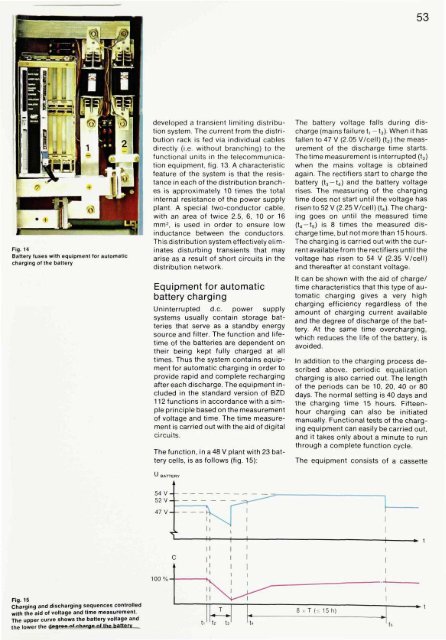saudi arabia-the largest telephone project in the world a new ...
saudi arabia-the largest telephone project in the world a new ...
saudi arabia-the largest telephone project in the world a new ...
- No tags were found...
You also want an ePaper? Increase the reach of your titles
YUMPU automatically turns print PDFs into web optimized ePapers that Google loves.
53Fig. 14Battery fuses with equipment for automaticcharg<strong>in</strong>g of <strong>the</strong> batterydeveloped a transient limit<strong>in</strong>g distributionsystem. The current from <strong>the</strong> distributionrack is fed via <strong>in</strong>dividual cablesdirectly (i.e. without branch<strong>in</strong>g) to <strong>the</strong>functional units <strong>in</strong> <strong>the</strong> telecommunicationequipment, fig. 13. A characteristicfeature of <strong>the</strong> system is that <strong>the</strong> resistance<strong>in</strong> each of <strong>the</strong> distribution branchesis approximately 10 times <strong>the</strong> total<strong>in</strong>ternal resistance of <strong>the</strong> power supplyplant. A special two-conductor cable,with an area of twice 2.5, 6, 10 or 16mm 2 , is used <strong>in</strong> order to ensure low<strong>in</strong>ductance between <strong>the</strong> conductors.This distribution system effectively elim<strong>in</strong>atesdisturb<strong>in</strong>g transients that mayarise as a result of short circuits <strong>in</strong> <strong>the</strong>distribution network.Equipment for automaticbattery charg<strong>in</strong>gUn<strong>in</strong>terrupted d.c. power supplysystems usually conta<strong>in</strong> storage batteriesthat serve as a standby energysource and filter. The function and lifetimeof <strong>the</strong> batteries are dependent on<strong>the</strong>ir be<strong>in</strong>g kept fully charged at alltimes. Thus <strong>the</strong> system conta<strong>in</strong>s equipmentfor automatic charg<strong>in</strong>g <strong>in</strong> order toprovide rapid and complete recharg<strong>in</strong>gafter each discharge. The equipment <strong>in</strong>cluded<strong>in</strong> <strong>the</strong> standard version of BZD112 functions <strong>in</strong> accordance with a simplepr<strong>in</strong>ciple based on <strong>the</strong> measurementof voltage and time. The time measurementis carried out with <strong>the</strong> aid of digitalcircuits.The function, <strong>in</strong> a 48 V plant with 23 batterycells, is as follows (fig. 15):The battery voltage falls dur<strong>in</strong>g discharge(ma<strong>in</strong>s failure t, —1 3 ). When it hasfallen to 47 V (2.05 V/cell) (t 2 ) <strong>the</strong> measurementof <strong>the</strong> discharge time starts.The time measurement is <strong>in</strong>terrupted (t 3 )when <strong>the</strong> ma<strong>in</strong>s voltage is obta<strong>in</strong>edaga<strong>in</strong>. The rectifiers start to charge <strong>the</strong>battery (t 3 -t 4 ) and <strong>the</strong> battery voltagerises. The measur<strong>in</strong>g of <strong>the</strong> charg<strong>in</strong>gtime does not start until <strong>the</strong> voltage hasrisen to 52 V (2.25 V/cell) (t 4 ). The charg<strong>in</strong>ggoes on until <strong>the</strong> measured time(t 4 -t 5 ) is 8 times <strong>the</strong> measured dischargetime, but not more than 15 hours.The charg<strong>in</strong>g is carried out with <strong>the</strong> currentavailable from <strong>the</strong> rectifiers until <strong>the</strong>voltage has risen to 54 V (2.35 V/cell)and <strong>the</strong>reafter at constant voltage.It can be shown with <strong>the</strong> aid of charge/time characteristics that this type of automaticcharg<strong>in</strong>g gives a very highcharg<strong>in</strong>g efficiency regardless of <strong>the</strong>amount of charg<strong>in</strong>g current availableand <strong>the</strong> degree of discharge of <strong>the</strong> battery.At <strong>the</strong> same time overcharg<strong>in</strong>g,which reduces <strong>the</strong> life of <strong>the</strong> battery, isavoided.In addition to <strong>the</strong> charg<strong>in</strong>g process describedabove, periodic equalizationcharg<strong>in</strong>g is also carried out. The lengthof <strong>the</strong> periods can be 10, 20, 40 or 80days. The normal sett<strong>in</strong>g is 40 days and<strong>the</strong> charg<strong>in</strong>g time 15 hours. Fifteenhourcharg<strong>in</strong>g can also be <strong>in</strong>itiatedmanually. Functional tests of <strong>the</strong> charg<strong>in</strong>gequipment can easily be carried out,and it takes only about a m<strong>in</strong>ute to runthrough a complete function cycle.The equipment consists of a cassetteFig. 15Charg<strong>in</strong>g and discharg<strong>in</strong>g sequences controlledwith <strong>the</strong> aid of voltage and time measurement.The upper curve shows <strong>the</strong> battery voltage and<strong>the</strong> lower <strong>the</strong> d»»grw "' charge of <strong>the</strong> battery















